Ayurveda Mahodadhi: Legumes Green Gram, Chickpea, Peas
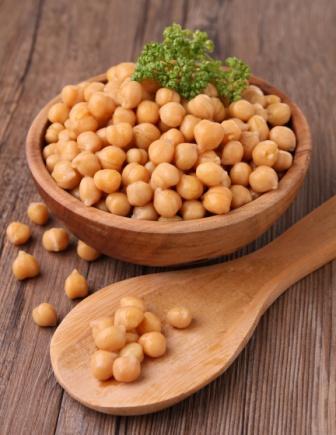
By Prof. Vd Rangaprasad Bhat.
Qualities of green gram, black gram, horse gram, mustard, chickpea etc are explained in Ayurveda Mahodadhi textbook of Sushena, written in 14th century.
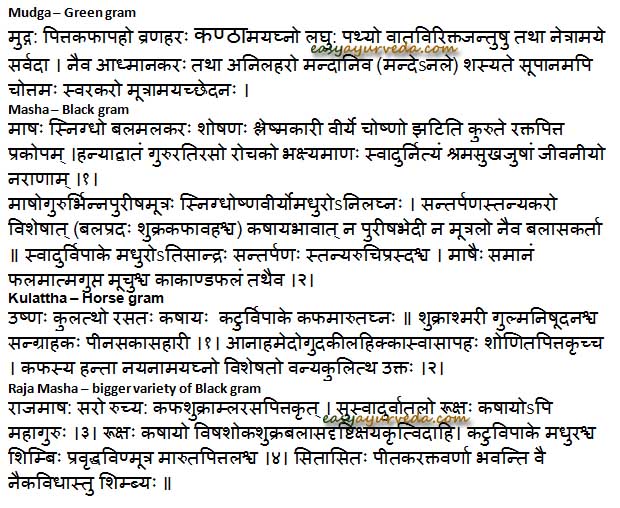
Table of Contents
Mudga
Mudga – Green gram:
Guṇa: laghu: (easy for digestion).
It is useful in pitta and kapha disorders, eye diseases
vraṇaharaḥ – (heals ulcers);
kaṃṭhāmayaghno – soothens the throat diseases;
It does not cause bloating of abdomen and hence acts as pacifier of vāta within the intestines
It augments the digestive fire
Svarakaro (good for voice);
mūtrāmayacchedanaḥ (clears urinary diseases).
Action on Doshās: Pittakaphāpaho (Reduces Pitta and kapha doshas);
sūpānamapi cottamaḥ (among all the varieties of soups prepared from the dhanya vargas, the green gram soup is superior.
Masha
Masha – black gram
madhura (sweeti)
Snigdho (oily);
gururati (heavy for digestion);
raso rocako bhakṣyamāṇaḥ (increases the perception of taste after consuming);
svādurnityaṃ (always provides a pleasant feeling of having eaten);
śramasukhajuṣāṃ ( negates the tiredness);
jīvanīyo narāṇām (provides enlivening of tissues to the person);
atisāndraḥ (when wet, it is highly viscid or thick).
Vīrya: uṣṇo (hot in potency).
Vipāka: svādurvipāke (post digestion it becomes sweetish).
balamalakaraḥ (it increases the physical strength and promotes the bulkiness of the faeces too);
śoṣaṇaḥ (it is dessicative in action);
jhaṭiti kurute raktapitta prakopam (it instantaneously causes aggravation of raktapitta);
bhinnapurīṣamūtraḥ (causes free evacuation of stools and urine);
santarpaṇastanyakaro (its nutritive and acts as a breast milk promoter);
viśeṣāt -balapradaḥ śukrakaphāvahaśca (it specifically provides strength to the kapha and shujra components in the body);
ruciprasdaśca (improves taste and appetite).
Action on Doshās:
śleṣmakārī (aggravates kapha); raktapitta prakopam (aggravates raktapittam); hanyādvātaṃ[anilaghnaḥ](subsides vātaṃ).
Similarity of guṇās of black gram is seen in other herbs such as Kapikacchu – Mucuna pruriens, and kākāṇḍaphalaṃ. |1-2|
Kulattha
Kulatha – Horse gram:
Rasa: rasataḥ kaṣāyaḥ (astringent in taste).
Guṇa: uṣṇaḥ (hot).
Vīrya: uṣṇaḥ (hot in potency).
Vipāka: kaṭurvipāke (pungent – post digestion).
Karma: ṣukrāśmarī (lithotriptic);
gulmaniṣūdanaśca (anti gulma);
sangrāhakaḥ(absorbent);
pīnasahārī (anti cold);
kāsahārī (anti tussive);
Action on Doshās: kaphamārutaghnaḥ (reduces kapha and vata).
The variety of kulattha named vanya kulattha has the following properties (viśeṣato vanyakulittha uktaḥ),-
ānāhāpahaḥ; medo apahaḥ (reduces corpulence);
gudakīlāpahaḥ (shrunkens the pile mass);
hikkāpahaḥ (controls the hiccough);
svāsāpahaḥ (eases the dyspnoea);
śoṇitapittakṛt ca (appease the blood and pitta);
nayanāmayaghno (wholesome in eye diseases).
Action on Doshās: kaphasya hantā (Control the kapha doSha).
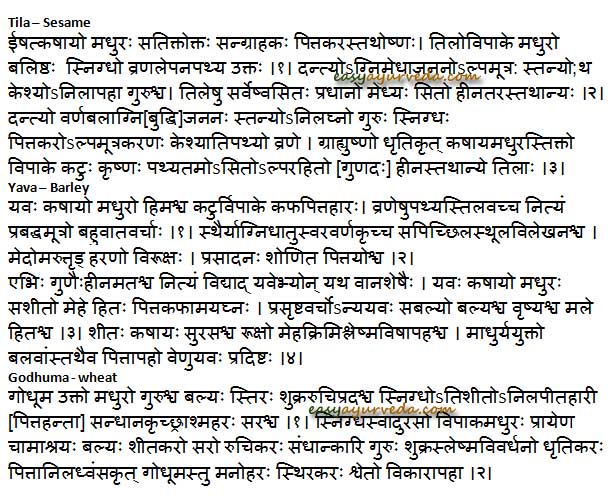
Rajamasha
Rajamasha – cow pea:
susvādu (sweetish);
kaṣāyo (astringent).
sara(fluidity);
rūkṣaḥ (rough);
mahāguruḥ (heavy for digestion);
Vipāka: kaṭuvipāke (becomes pungent post digestion).
rucya: (appetizer);
śukrākṛt (increases shukra dhatu);
It reduces the toxicity, inflammation, shukra and Kapha immunity);
vidāhi (causes burning within the channels of the body);
pravṛddhaviṭ (increases the bulkiness of the stools);
pravṛddhamūtra(increases the quantity of urine production);
pravṛddha mārutapittalaśca (increases the pitta and vata insode the gastro intestinal tract, quantitatively).
Krishna Tila
Krishna Tila – Black sesame –
It is being said that “tileṣu sarveṣvasitaḥ pradhāno medhyaḥ”, means the black sesame is superior than the other varieties because of its medhya (promotes intelligence) property.
īṣatkaṣāyo madhuraḥ satiktoktaḥ (Slightly astringent and sweetish as primary taste and bitterness as secondary taste)
Uṣṇaḥ (hot in potency);
baliṣṭhaḥ snigdho (highly unctuous);
guruśca (heavy for digestion).
Vipāka: It is Sweet – post digestion (vipāke madhura).
sangrāhakaḥ (absorbent of the watery portions in intestines);
wholesome in ulcer patients);
Dantyo (strengthens the tooth);
agni janano (incites jaṭharāgni);
medhā janano (promotes intelligence);
alpamūtra: (controls the quantity of urine formation)
stanyo (promotes breast milk);
Keśyo (tonic to hair);
Action on Doshās: It increases the pitta and decreases the vāta (pittakara ; anilāpahā).
Shweta tila
Shweta tila – White sesame seed
White sesame is inferior to black sesame.
Rasa: kaṣāya madhuras tikto (astringent, madhura and bitter respectively).
Guṇa: hot in potency (uṣṇo) ; heavy for digestion (guruḥ) ;unctuous (snigdhaḥ).
Vipāka: Pungent (vipāke kaṭuḥ)
Karma: dantyo jananaḥ (promotes tooth formation) ;
varṇa jananaḥ (increases complexion of skin) ;
bala jananaḥ (provides physical strength);
agni[buddhi] jananaḥ (promotes the buddhi vaisheshika agni/intelligence) ;
stanyo (promotes breast milk production);
alpamūtrakaraṇaḥ (controls the quantity of urine formation);
Keśya (hair tonic);
atipathyo vraṇe (accepted as the best wholesome dravya in patients of ulcers);
grāhi (absorbent action in intestines);
dhṛtikṛt (improves the determination ability of a person).
Action on Doshās: It reduces the vāta and increases the pitta (anilaghno ; pittakaro).
Yava
Yava – Barley:
Two types.
yava (barley) and
veṇūyavaḥ (bamboo seed- a variety of kudhAnya). [1-2]
Rasa: kaṣāyo madhura – astringent and sweet
Guṇa: himaśca (cold in potency);
virūkṣaḥ (dryness).
Vipāka: Pungent – Katu
Karma: As like the sesame, barley too is a wholesome legume which is beneficial to patients of ulcers over the skin surface.
When consumed daily it acts as diuretic and bulk promoting agent for feces,
Black gram increases the presence of vata in the intestines
It provides firmness to the body parts by reducing the excessive fat depositions (sthairyakṛt);
ignites the jaṭharāgni (agnidhātukṛt); smoothens the voice (svarakṛt); improves the skin complexion (varṇakṛt); It causes scraping action over the excessive sticky factors in body and also reduces the obesity (sapicchila sthūla vilekhanaśca); counters the bodily fat (medo haraṇo); (tṛḍ haraṇo); (prasādanaḥ śoṇita pittayośca).
Action on Doshās: Controls the aggravated kapha primarily followed by the pitta (kapha pittahāraḥ);
It expels the marut/wind (flatus) from the body (marut haraṇo) .
Venuyava
Venuyava – Bamboo seed
The same gunas of barley are present in lower potency
The yava procured from the forests which is known as veṇūyavaḥ (Bamboo seed). [3-4]
Rasa: Astringent and sweet
Whitish in colour (sa śīto); rūkṣo (dryness).
Vīrya: śītaḥ (cold in potency).
Karma: Counteracts diabetes and pitta kaphaja diseases
acts as laxative
provides strength (balyo);
promotes virility (vṛṣyaśca);
forms bulkiness of the feces (malehitaśca);
controls excessive urination (mehāpaha);
negates the intestinal worms ( krimi āpaha);
reduces the effect of toxins (viṣāpaha).
Action on Doshās: Appeases the kapha and pitta dosha
Godhuma
Godhuma – wheat
Rasa: madhura – sweet
Guru – heavy to digest
stiraḥ (stability);
snigdho (unctuous);
atiśīto saraśca (excessively cold and liquidity);
āmāśrayaḥ (causative for āmā production within the channels).
Vipāka: madhuraḥ (sweetish in taste post digestion).
Karma: balyaḥ (strength promoting);
Śukraprada (shukra dhAtu promoting);
ruciprada(kara) (improves appetite);
sandhānakāri (enhances binding action of the tissues);
aśmaharaḥ (lithotriptic);
Śukra vivardhana (increases shukra dhatu);
dhṛtikaraḥ (provides stability to body and body parts);
manoharaḥ (pleasant to eat and taste);
sthirakaraḥ ; śveto vikārāpahā .
Action on Doshās: anilahārī (appeases the vata doSha); pītahārī (reduces the pitta); sleṣma vivardhana (increases the kapha doSha).
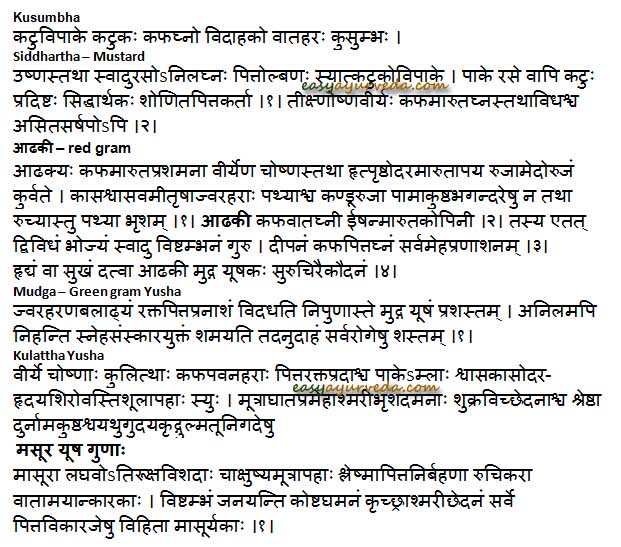
Kusumbha
Kusumbha – Carthamus tinctorius
Rasa: kaṭukaḥ – spicy, pungent
Guṇa: vidāhi (causes burning sensation within the body channels).
Vipāka: kaṭuvipāke (pungent in vipāka).
Karma: vidāhako (causes burning sensation within the body channels).
Action on Doshās: kaphaghno vātaharaḥ (negates the kapha and vāta doṣās).
Hence this kudhAnya is not a suitable one to be consumed as a staple food, but can be consumed in diseases caused by the kapha and vāta doṣās.
Siddarthaka
Siddhartaka – mustard:
svāduraso (primarily sweetish);
upon cooking the mustard seed it predominantly has pungent taste)
Vīrya: uṣṇa (hot in potency).
Vipāka: kaṭukovipāke (pungent-post digestion).
Karma: śoṇitapittakartā (aggravates the rakta and pitta;s qualities).
Action on Doshās: anilaghnaḥ (alleviates vāta); pittolbaṇaḥ (increases pitta in excess quantity).
Adhaki
Adhaki – red gram: Pigeon pea:
It is wholesome in pāmā,
kuṣṭha – skin disorders
Bhagandara – fistula in ano etc when taken in small quantity.
But if it is consumed in excess, it does not taste good neither it is wholesome.
Since pigeon pea is sweet and can cause constipation, for the purpose of digesting it and counteracting the kapha-pitta doshas – two methods for consuming the red gram are advised
1. they be consumed along with green gram in the form of yusha (soup), or
2. they be mixed with rice and cooked for consumption to make the act of consuming red gram with a experience of good taste. [3-4]
Adhaki – Pigeon pea:
Rasa: svādu (sweetish –primary taste)
Guṇa: viṣṭambhanaṃ (clogs the internal channels);causes constipation
guru (heavy for digestion).
Vīrya: Ushna (hot in potency).
Karma: hṛt-mārutāpaya (controls the aggravated vāta in the pectoral region);
pṛṣṭha-mārutāpaya (controls the aggravated vāta in the vertebral region);
udara-mārutāpaya (controls the aggravated vāta in the in abdominal region);
rujā kurvate (when taken in excess causes colic);
medorujaṃ kurvate (when taken in excess causes obesity);
Kāsaharāḥ (anti tussive);
śvāsaharāḥ (eases dyspnoea);
vamīharāḥ (anti emetic);
tṛṣāharāḥ (relievs thirst);
jvaraharāḥ (antipyretic);
Action on Doshās: Balances Kapha and Vata Dosha It can increase Vata Dosha if taken in excess quantity.
It balances Kapha and Pitta if consumed in the form of soup combined with green gram or when partaken by cooking blended with the rice – in either case the quantity of red gram used should be in minimal and restricted quantity). [1-4]
Mudga Yusha
Mudga Yusha – green gram soup:
Karma: jvaraharaṇa (antipyretic);
balāḍhyaṃ pranāśaṃ (helps controlling acute rheumatism);
Raktapitta pranāśaṃ (controls the bleeding diasthesis).
Action on Doshās: anilam nihanti(pacifies the
when the mudga soup is taken along with the oils and fats, it relieves the burning caused by inflammation);
It is a good diet in almost any given diseases.
Kulattha Yusha
Kulattha Yusha – horse gram soup:
Astringent in taste
Hot – Ushna
Vipāka: Pāke amlāḥ (Post digestion it is acrid in taste).
Useful in
Shwasa – asthma,
Kasa – cough
Udara shoola – abdominal colic pain
Vasti shoola – bladder pain
Action on Doshās: Balances Kapha and Vata Dosha. Does not increase Pitta to a large extent.
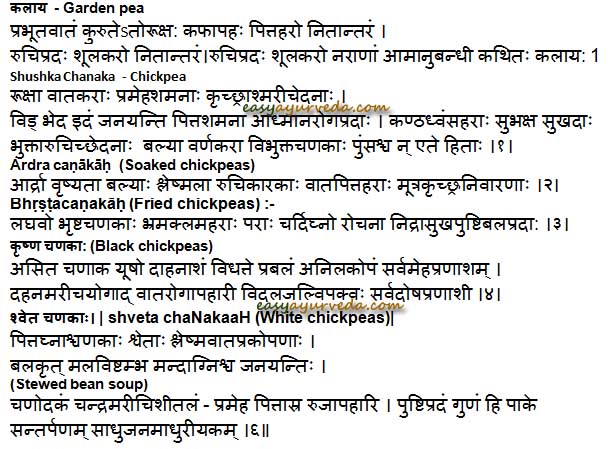
Masura Yusha
Masura Yusha – lentil soup:
Guṇa: Laghavo(light);
atirūkṣa( excessively dry);
viśadāḥ(clarity).
cākṣuṣya(good for eyes
Mutrapaha – decreases urine flow
Ruchikara – improves taste, useful in anorexia.
Action on Doshās: Decreases Kapha and Pitta. Increases Vata Dosha.
Kalaya
Kalaya – (peanut) guṇā:
Rooksha – dryness
Balances Kapha Dosha
Pittahara – useful in Pitta imbalance disorders such as gastritis, burning sensation, etc.
Ruchiprada – improves taste
Can cause abdominal pain
Can Cause Ama – A product of indigestion and altered metabolism.
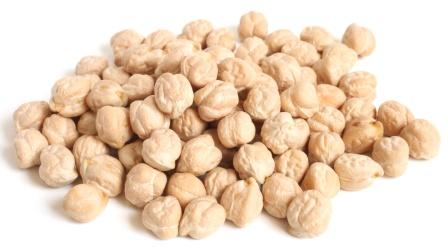
Chanaka
Chanaka – dry Chick pea / bengal gram
Guṇa: rūkṣā
Karma: prameha śamanāḥ(controls prameha- urinary disorders, diabetes
useful in renal calculi
may cause constipation, bloating,
Soothes hoarseness of voice);
Gives a pleasant feeling upon chewing it;
improves taste after eating
promotes physical strength
improves complexion).
Action on Doshās: vātakarāḥ (increases vata); pittaśamanā (decreases pitta).

Ardra Chanaka
Ārdra caṇākāḥ Soaked chickpeas
Vrushya – aprhdosiac
balyāḥ (promotes strength);
mūtrakṛcchranivāraṇāḥ (relieves dysuria);
rucikārakāḥ (provides taste);
śleṣmalā (increases kapha doSha);
vātapittaharāḥ (controls vāta and pitta).
Brishta Chanaka
Brishta Chanaka – fried chickpea:
It is light for digestion;
Relieves giddiness and tiredness (bhramaklamaharāḥ);
controls vomiting (cardighno);
augments the taste perception (rocanā);
augments good sleep (nidrāsukhapradā);
nutritive (puṣṭi);
augments physical strength(balapradā:) .
Krishna Chanaka
कृष्ण चणका: (Black chickpeas)
The yūṣa (soup) prepared out of black chickpeas is
dāhanāśaṃ (soothens from burning sensation);
Vidhatte prabalaṃ (provides good amount of physical strength);
sarvamehapraṇāśam (controls all varieties of pramehas – urinary tract infection);
anilakopaṃ (aggravates vāta);
when cooked along with black pepper, it acts against the vāta rogās).
Shweta Chanaka
Shveta Chanaka – White chickpea:
Balakṛt (promotes physical strength);
malaviṣṭambha (causes constipation);
mandāgniśca janayantiḥ (causes decrease in the functioning of agni due to its guru guNa).
Chanodakam
Caṇodakaṃ (the water of soaked white chick peas) kept over night exposed to the cool rays of moon (candramarīciśītalaṃ) when consumed is beneficial in persons suffering from urinary disorders, bleeding disorders and bodyache.
The mādhurīyakam (stewed bean soup) of white chick peas due to its nourishing qualities increases the wellbeing of the person after undergoing efficient cooking.
Click to consult Vd. Rangaprasad Bhat










4 comments
Jesse
Dear sir/madam,
Thank you for your article.
I was wondering, I thought kalaya mean normal peas and not pea-nuts? And how can peanut be ruskha when ruksha is the opposite of oily, and peanuts are used to extract oil?
Kind regards,
Jesse
Dr J V Hebbar MD(Ayu)Author
Harenu means pea / greenpea.
Kalaya is peanuts.
Prasad A
What are properties of peanut butter & its effect on body and doshas
Dr J V Hebbar MD(Ayu)Author
An article on this topic is coming up shortly.